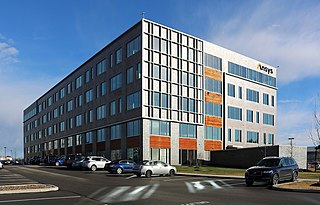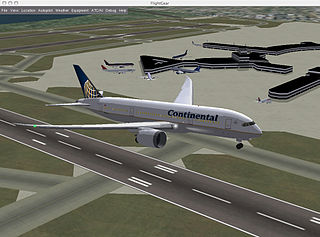Related Research Articles

A simulation is an imitative representation of a process or system that could exist in the real world. In this broad sense, simulation can often be used interchangeably with model. Sometimes a clear distinction between the two terms is made, in which simulations require the use of models; the model represents the key characteristics or behaviors of the selected system or process, whereas the simulation represents the evolution of the model over time. Another way to distinguish between the terms is to define simulation as experimentation with the help of a model. This definition includes time-independent simulations. Often, computers are used to execute the simulation.

Computer simulation is the process of mathematical modelling, performed on a computer, which is designed to predict the behaviour of, or the outcome of, a real-world or physical system. The reliability of some mathematical models can be determined by comparing their results to the real-world outcomes they aim to predict. Computer simulations have become a useful tool for the mathematical modeling of many natural systems in physics, astrophysics, climatology, chemistry, biology and manufacturing, as well as human systems in economics, psychology, social science, health care and engineering. Simulation of a system is represented as the running of the system's model. It can be used to explore and gain new insights into new technology and to estimate the performance of systems too complex for analytical solutions.
Simulation video games are a diverse super-category of video games, generally designed to closely simulate real world activities. A simulation game attempts to copy various activities from real life in the form of a game for various purposes such as training, analysis, prediction, or entertainment. Usually there are no strictly defined goals in the game, and the player is allowed to control a character or environment freely. Well-known examples are war games, business games, and role play simulation. From three basic types of strategic, planning, and learning exercises: games, simulations, and case studies, a number of hybrids may be considered, including simulation games that are used as case studies. Comparisons of the merits of simulation games versus other teaching techniques have been carried out by many researchers and a number of comprehensive reviews have been published.

Ansys, Inc. is an American multinational company with its headquarters based in Canonsburg, Pennsylvania. It develops and markets CAE/multiphysics engineering simulation software for product design, testing and operation and offers its products and services to customers worldwide.

Electronic circuit simulation uses mathematical models to replicate the behavior of an actual electronic device or circuit. Simulation software allows for modeling of circuit operation and is an invaluable analysis tool. Due to its highly accurate modeling capability, many colleges and universities use this type of software for the teaching of electronics technician and electronics engineering programs. Electronics simulation software engages its users by integrating them into the learning experience. These kinds of interactions actively engage learners to analyze, synthesize, organize, and evaluate content and result in learners constructing their own knowledge.
Simulation software is based on the process of modeling a real phenomenon with a set of mathematical formulas. It is, essentially, a program that allows the user to observe an operation through simulation without actually performing that operation. Simulation software is used widely to design equipment so that the final product will be as close to design specs as possible without expensive in process modification. Simulation software with real-time response is often used in gaming, but it also has important industrial applications. When the penalty for improper operation is costly, such as airplane pilots, nuclear power plant operators, or chemical plant operators, a mock up of the actual control panel is connected to a real-time simulation of the physical response, giving valuable training experience without fear of a disastrous outcome.
A dispatcher training simulator (DTS), also known as an operator training simulator (OTS), is a computer-based training system for operators of electrical power grids. It performs this role by simulating the behaviour of the electrical network forming the power system under various operating conditions, and its response to actions by the dispatchers. Student dispatchers may therefore develop their skills from exposure not only to routine operations but also to adverse operational situations without compromising the security of supply on a real transmission system.
A serious game or applied game is a game designed for a primary purpose other than pure entertainment. The "serious" adjective is generally prepended to refer to video games used by industries like defense, education, scientific exploration, health care, emergency management, city planning, engineering, politics and art. Serious games are a subgenre of serious storytelling, where storytelling is applied "outside the context of entertainment, where the narration progresses as a sequence of patterns impressive in quality ... and is part of a thoughtful progress". The idea shares aspects with simulation generally, including flight simulation and medical simulation, but explicitly emphasizes the added pedagogical value of fun and competition.
Project management simulation is simulation used for project management training and analysis. Project management simulation is often used as training simulation for project managers. In other cases it is used for what-if analysis and for supporting decision-making in real projects. Frequently the simulation is conducted using software tools.
An instructional simulation, also called an educational simulation, is a simulation of some type of reality but which also includes instructional elements that help a learner explore, navigate or obtain more information about that system or environment that cannot generally be acquired from mere experimentation. Instructional simulations are typically goal oriented and focus learners on specific facts, concepts, or applications of the system or environment. Today, most universities make lifelong learning possible by offering a virtual learning environment (VLE). Not only can users access learning at different times in their lives, but they can also immerse themselves in learning without physically moving to a learning facility, or interact face to face with an instructor in real time. Such VLEs vary widely in interactivity and scope. For example, there are virtual classes, virtual labs, virtual programs, virtual library, virtual training, etc. Researchers have classified VLE in 4 types:

Aimsun Live is a traffic forecasting solution based on simulation, developed and marketed by Aimsun.
Vortex Studio is a simulation software platform developed by CM Labs Simulations. It features a real-time physics engine that simulates rigid body dynamics, collision detection, contact determination, and dynamic reactions. It also contains model import and preparation tools, an image generator, and networking tools for distributed simulation which is accessed through a desktop editor via a GUI. Vortex adds accurate physical motion and interactions to objects in visual-simulation applications for operator training, mission planning, product concept validation, heavy machinery and robotics design and testing, haptics devices, immersive and virtual reality (VR) environments.

A flight simulation video game refers to the simulation of various aspects of flight or the flight environment for purposes other than flight training or aircraft development. A significant community of simulation enthusiasts is supported by several commercial software packages, as well as commercial and homebuilt hardware. Open-source software that is used by the aerospace industry like FlightGear, whose flight dynamics engine (JSBSim) is used in a 2015 NASA benchmark to judge new simulation code to space industry standards, is also available for private use. A popular type of flight simulators video games are combat flight simulators, which simulate combat air operations from the pilot and crew's point of view. Combat flight simulation titles are more numerous than civilian flight simulators due to variety of subject matter available and market demand.

Port operations simulators are applications of simulation technology used to determine the outcomes of potential changes to factors affecting ports, security policies, traffic patterns, port expansion or growth, natural disasters, inclement weather, or terrorist activity.
The ADMS is an emergency and disaster management training simulation system designed to train incident commanders, first responders, and incident command teams in a real-time, interactive virtual reality environment. ADMS was first introduced by Environmental Tectonics Corporation (ETCC:US) in 1992. The development of ADMS was in response to the crash of British Airtours Flight 28M at the Manchester airport in 1985, in which 55 people died. Following the accident research indicated that first responder training should include realistic scenarios. The first ADMS system was produced for the UK Ministry of Defence, and delivered to Royal Air Force's (RAF) Manston Facility. Since its inception, ADMS has evolved into a modular, expandable disaster simulation platform, with systems in use worldwide.
Print process simulation uses interactive simulation software to reproduce the operating conditions of complex multi-colour printing presses that often cost several million dollars. Simulators are available for different printing process technologies, includes their consumables and where pertinent, in-line packaging operations.
SkyRadar is a European research and development company for radar technology and aviation security. It manufactures radar hardware and simulators for training, education and research. It was founded in 2008 as a joint venture of several European participants. The team is conducting active research embedded in several international research programs and operates a not for profit knowledge portal, providing e-Learning and academic publications.
References
- 1 2 Project Management Institute "Project Management Institute Honors The Technion-Israel Institute of Technology", October 20, 2008 "The Technion-Israel Institute of Technology Honored | Project Management Institute". Archived from the original on 2012-03-20. Retrieved 2011-08-11.
- ↑ Shtub Avraham, "Project Management Simulation with PTB Project Team Builder", Springer Science+Business Media, 2012, March, ISBN 978-1-4419-6462-5
- ↑ Davidovitch, L., A. Parush and A. Shtub, April, 2008, Computers & Education, Vol. 50, No. 3, 866–880
- ↑ Davidovitch, L., A. Parush and A. Shtub, March, 2009, International Journal of Engineering Education, Vol. 25, No. 2, 333–340(8)
- ↑ Nembhard, D., K. Yip and A. Shtub, April, 2009, International Journal of Engineering Education, 181–192
- ↑ Shtub, A., A. Parush and T. Hewett, March, 2009, International Journal of Engineering Education [ permanent dead link ], Vol. 25, No. 2, 206–209
- ↑ Parush, A., L. Davidovitch and A. Shtub, May, 2010, IEEE Transactions on Engineering Management', Vol. 57, No. 2, 288–300
- ↑ Vanhoucke, M. and A. Shtub, January, 2011, PM World Today,(featured paper), Vol. XIII, Issue I
- ↑ Davidovitch, L., A. Shtub and A. Parush, April, 2008, PMS 2008, Istanbul, Turkey
- ↑ Shtub, A., April, 2011, POMS 22nd Annual Conference Reno, Nevada, U.S.A
- ↑ Cohen I., Iluz, M., and Shtub A.,Systems Engineering (2013)
- ↑ Shtub, A., PM World Journal, Vol. II, Issue XI – November 2013
- ↑ Zwikael, O., Shtub, A. and Chih, Y., Journal of Management in Engineering (June 2013)